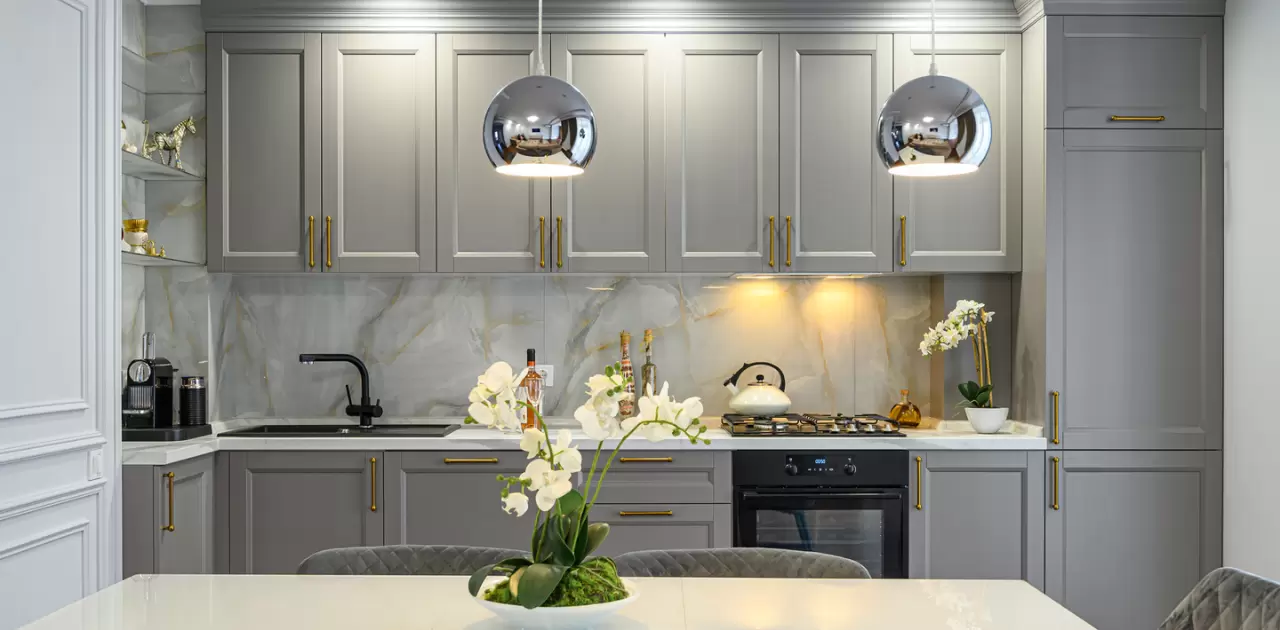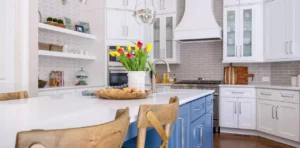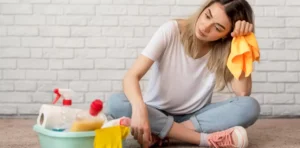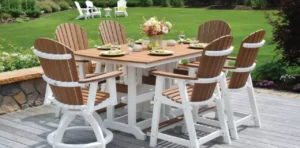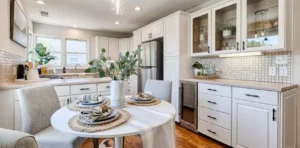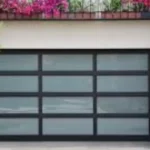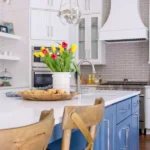Are your kitchen cabinets in need of a fresh look? Before you break out the paintbrushes. It is crucial to prepare them properly. Cleaning kitchen cabinets before painting is essential for a long-lasting finish.
Grease grime and other residues can prevent paint from adhering properly leading to chipping and peeling. By taking the time to clean your cabinets thoroughly you will ensure a smooth and durable paint job.
In this guide we will walk you through the process of cleaning your kitchen cabinets step by step. From assembling your cleaning supplies to tackling stubborn stains and odors.We will cover everything you need to know to get your cabinets ready for a fresh coat of paint.
Why Cleaning Cabinets Before Painting is Crucial
Cleaning cabinets before painting is crucial because it ensures proper adhesion of the new paint. Grease grime and other residues on the surface can create a barrier causing the paint to peel or chip prematurely.
Without thorough cleaning the paint may not bond evenly resulting in an unsightly finish that detracts from the overall appearance of your kitchen.Cleaning helps to remove any dirt or contaminants that could affect the longevity of the paint job.
By investing the time and effort to clean your cabinets before painting you will create a smooth and clean surface that allows the paint to adhere properly. This preparation step is essential for achieving professional looking results and ensuring that your newly painted cabinets stand the test of time.
Assemble Your Cabinet Cleaning Arsenal
Before starting, gather all the necessary supplies. Having these ready prevents delays and frustrating interruptions mid-clean:
Cleaning Supplies
- Degreasing solution (such as Krud Kutter)
- Scouring pads (green or blue abrasive type)
- Cleaning rags (lots of clean, absorbent cloths)
- White vinegar and baking soda (for odors/stains)
- Plastic buckets/spray bottles
- Rubber gloves
- Drop cloths or plastic sheeting
- Putty knife and wood filler
- Medium (100-150 grit) sandpaper or sanding blocks
- Vacuum with hose attachment
- Painter’s tape
Repair Supplies
- Putty knife and wood filler
- Sandpaper or sanding blocks (100-150 grit)
- Vacuum cleaner with hose attachment
- Painter’s tape
Inspect Those Cabinets! (What to Look For)
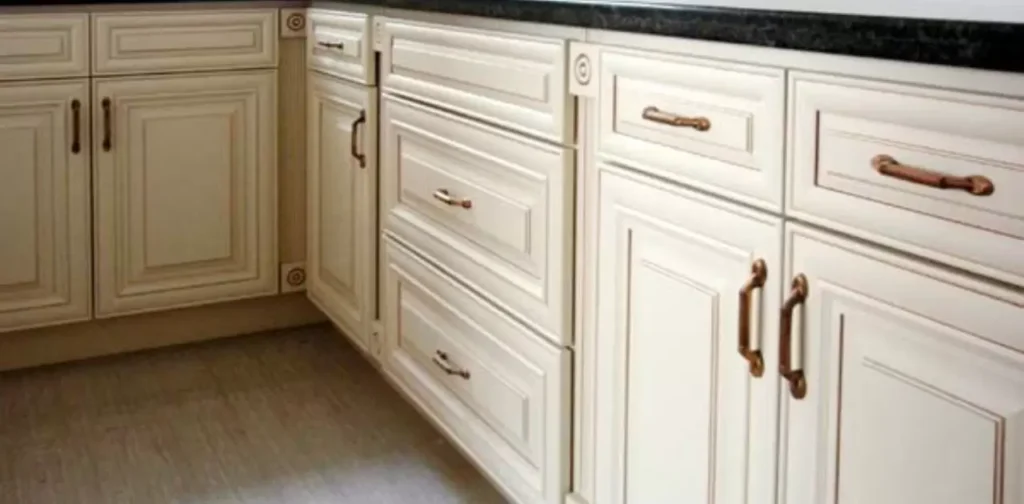
Inspecting your cabinets before cleaning is crucial to identify problem areas. Look for heavy grease and grime around the stove/oven under the microwave behind/under the sink and in cabinet edges/corners.
Check for sticky spills crayon marks loose veneer or other surface damage that may require special attention during the cleaning and preparation process.
Also read this: CHOICE HOME WARRANTY GEORGE FOREMAN ALL NEED TO KNOW
Time to Get Scrubbing: The Degreasing Process
It is time to tackle the degreasing process and get those cabinets sparkling clean. First mix a degreasing solution by adding the recommended amount of cleaner to warm water in a plastic bucket.
Then apply the solution generously to all cabinet surfaces including frames doors drawers and interior boxes.Next grab your scouring pads and start scrubbing away the grease and grime using small circular motions.
Be sure to focus on areas with heavy buildup such as around the stove under the microwave and near the sink. Rinse with clean water and wipe away any residue before fully drying the cabinets with absorbent towels.
Dealing With Stubborn Stains and Odors
For stubborn stains and odors you will need to bring out some powerful solutions. Try wiping down cabinets with undiluted white vinegar to combat musty odors letting it soak before scrubbing and rinsing.
If dealing with yellowed nicotine stains make a baking soda paste let it sit for 5-10 minutes then scrub to lift the stains gently.When faced with really tough baked-on gunk consider using a solvent like mineral spirits or oven cleaner.
but be cautious and test in an inconspicuous area first. These methods can help eliminate lingering odors and stains ensuring your cabinets are fresh and ready for a new paint job.
Don’t Skip This Step! Scuff Sanding is Key
Do not underestimate the importance of scuff sanding before painting your cabinets. This crucial step ensures proper adhesion of the new paint by roughing up the smooth surfaces allowing the primer and paint to grip effectively.
Use 100-150 grit sandpaper or sanding blocks to create a slightly textured surface without sanding down to bare wood. Thoroughly vacuum up any dust before proceeding to the next steps for a flawless finish that lasts.
How to Sand for Painting
When sanding for painting start in a back corner and work methodically around door and drawer fronts as well as cabinet frames and interior boxes. Use 100-150 grit sandpaper or sanding blocks to lightly rough up the surface following the grain direction as much as possible. Be sure to vacuum up all dust thoroughly before moving on to the next steps ensuring optimal adhesion for your paint.
Repairing Dents, Holes, and Damage
Repairing dents holes and damage is essential for achieving a smooth and flawless paint finish on your kitchen cabinets. Begin by cleaning out any debris from the affected areas and filling them with wood filler slightly overfilling the damaged area before smoothing it out with a putty knife. Once the filler has dried completely sand the repaired areas until they are flush with the surrounding surface ensuring a seamless look after painting.
The Importance of Proper Priming
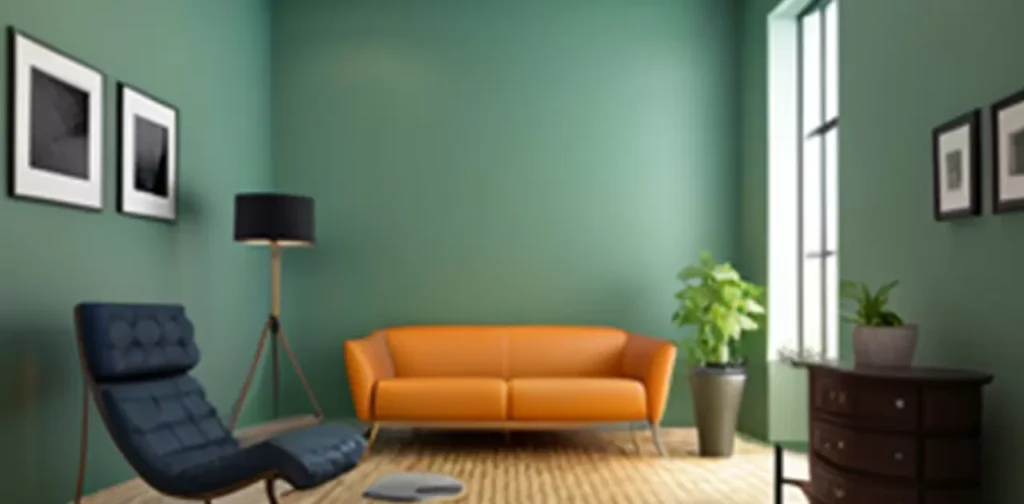
With all that intense cleaning and sanding complete the next vital step is priming the cabinets. Do not even think about skipping straight to painting.Primer helps:
- Proper priming ensures optimal adhesion of the paint to the cabinet surfaces.
- It helps to block stains and odors from bleeding through the paint.
- Priming evens out the surface texture resulting in a smoother finish.
- It allows the topcoat of paint to cure properly for enhanced durability.
- Oil-based primers like KILZ or Zinsser are often recommended for their superior adhesion and stain-blocking properties.
Also read this: HOW TO SEPARATE KITCHEN FROM LIVING ROOM
Pro Painting Tips (Bonus Section)
In the pro painting tips section you will find valuable insights to take your cabinet painting project to the next level. These tips include:
- Paint Selection: Opt for high-quality acrylic alkyd or hybrid enamel paints specifically designed for cabinets such as Benjamin Moore Advance or Sherwin-Williams Emerald Urethane.
- Brush vs. Spray: Consider the advantages of using brushes for better control in crevices versus using sprayers for a smoother finish, balancing your preference with the desired outcome.
- Prepping for Spraying: Remove cabinet doors and drawers, set up a spray area with proper ventilation, and lightly score surfaces with denatured alcohol for improved paint adhesion.
- Proper Paint Technique: Start painting with doors face-up, then move on to bases and frames, applying at least two coats with light sanding between each for a professional finish.
- Reassembly: Allow painted surfaces to fully cure for 3-7 days before reattaching cabinet doors and drawers checking for sticking and lubricating hinges and glides as needed. These expert tips will help you achieve exceptional results and enjoy your beautifully painted cabinets for years to come.
Frequently asked questions
What is the best cleaner for kitchen cabinets?
Krud Kutter is highly recommended for cleaning kitchen cabinets due to its powerful degreasing properties and effectiveness in removing stubborn grime and grease buildup.
What is the best way to clean wood before painting?
The best way to clean wood before painting is to use a degreaser to remove any grease or grime followed by lightly sanding the surface with 100-150 grit sandpaper to create a smooth paint-ready surface.
How to degrease kitchen cabinets?
To degrease kitchen cabinets apply a degreasing solution like Krud Kutter scrub the surfaces with scouring pads rinse with water and thoroughly dry with clean towels. Repeat as needed for stubborn grease buildup.
What is the best kitchen cabinet primer?
Oil-based primers such as KILZ or Zinsser are often considered the best for kitchen cabinets due to their superior adhesion and ability to block stains effectively providing a solid foundation for the paint to adhere to.
Does vinegar clean kitchen cabinets?
Yes, vinegar can effectively clean kitchen cabinets especially for removing odors and mold stains. Its acidic properties help break down grease and grime leaving cabinets fresh and clean.
Conclusion
Thorough cleaning and preparation are essential for achieving a successful cabinet painting project that stands the test of time. By investing the time and effort to degrease sand prime and paint your cabinets properly you ensure a smooth and durable finish that enhances the overall look of your kitchen.
Remember skipping any of these crucial steps can lead to paint adhesion issues chipping and peeling down the road. So grab your cleaning supplies, follow the steps outlined in this guide and enjoy the satisfaction of revitalizing your kitchen with freshly painted cabinets that will stay beautiful for years to come.
